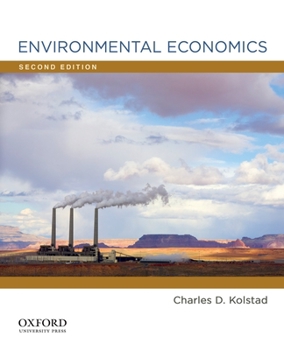Environmental Economics
Select Format
Select Condition 
Book Overview
Environmental Economics is the first text to concentrate solely on environmental economics--the problems of earth, air, and water pollution from an economic perspective--with an emphasis on both government regulation and private-sector anti-pollution incentives. With the assumption that readers already have an understanding of intermediate microeconomics, the book reaches into more detail on theory and analysis than most other textbooks in this area. Now fully revised in its second edition, Environmental Economics is divided into four primary sections: the first section defines the field of environmental economics in relation to general economics and to ecological and resource economics; the second section is normative, looking at market failure and asks why, even with apparent environmental protection, the market often fails to work properly; the third section is positive, examining government regulation of pollution using the industrial organization literature; and the final section covers more advanced topics, looking at risk, uncertainty, green accounting, international competition and cooperation and development. Including many international examples, the book places special emphasis on the ways that countries around the world approach and control their own environmental problems. Environmental Economics, Second Edition, is ideal for undergraduate economics courses and beginning graduate courses in environmental management. New to this Edition
* Utilizes a new structure: the first part is normative, the second part positive
* Provides an updated treatment of valuation and moves it to the first part of the text
* Substantially revises coverage of cost-benefit analysis, property rights, and market failure, resulting in greater clarity
* Includes new chapters on voluntary environmental protection and additional sections on discounting and dynamics
* Offers increased coverage of open access resources and fisheries
* The technical level throughout the text is much more consistent from chapter to chapter
* Utilizes a new structure: the first part is normative, the second part positive
* Provides an updated treatment of valuation and moves it to the first part of the text
* Substantially revises coverage of cost-benefit analysis, property rights, and market failure, resulting in greater clarity
* Includes new chapters on voluntary environmental protection and additional sections on discounting and dynamics
* Offers increased coverage of open access resources and fisheries
* The technical level throughout the text is much more consistent from chapter to chapter
Format:Hardcover
Language:English
ISBN:0199732647
ISBN13:9780199732647
Release Date:March 2010
Publisher:Oxford University Press
Length:496 Pages
Weight:2.33 lbs.
Dimensions:1.2" x 7.6" x 9.3"
Customer Reviews
2 ratings
Great introduction to Environmental Economics .
Published by Thriftbooks.com User , 23 years ago
Actual rating - 4.5 stars .I read this book as a must-read for the Environmental Economics course I had taken in the beginning of the last semester . I think this book is a great choice for students that are interested in this topic . Myself , I didn't know what to expect in the beginning of the course , but it turned up to be a surprisingly interesting and important issue - with the good help of this book .I have to say that I've learned a lot from reading this book , and it has been a pleasant experience too . Professor Kolstad has really accomplished a commendable achievement in writing a fluent , methodical , thorough and interesting book about Environmental Economics , nearly everyone who wishes to , can read and understand . I say it as a student who hasn't read other works on the subject , but nevertheless , feels this book has many pluses as an introduction to this subject :- The author , in spite of announcing it is a book for persons that have taken an Intermediate Microeconomics courses , makes far-reaching efforts to explain nearly every statement he proclaimed . This is a good feature students can use for reviewing forgotten material , deleting the need to use more fundamental books for understanding .- Significant number of chapters includes a small use of mathematic tools . This fact is of considerable help for the layman , who is interested in expending horizons and lacks the necessary mathematical skills . I believe the following points characterize many tutorials , but it's important to note them anyway; - Every figure the author uses is accompanied with detailed explanations that enhance the reader's ability to understand the sketch and the whole subject while at it .- Every chapter includes an introduction and a summery . The first connects the chapter to the previous one , and assists in grasping the place it takes in the big picture of things , while the second one summarize the major issues dealt with . This functions organize the material and construct an understandable structure of knowledge .- One last thing , that consists an advantage constructed with disadvantage is the appearance of questions and problems in the end of each chapter , in the obvious order to help you check out your understanding , but with the irritating absence of answers and solutions (!) . What's the point in composing personal examinations without any achievable , certified solutions ? How can I know I am right ? I recommend authors to annex a booklet/extra pages with the correct answers , along with a full description of the way to the solution plus explanations - if you include such a tutorial tool in your book - do it right .Excluding the last disadvantage , I'm most pleased with this book , and would recommend it for anyone who is interested in environment and its protection problems
complete and comprenhensive
Published by Thriftbooks.com User , 25 years ago
This book is more than a simple overview of the wide environmental economics world, since it embraces the subject in a clear, comprenhensive but in-depth enough to get a very good picture of it.






